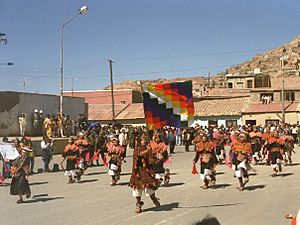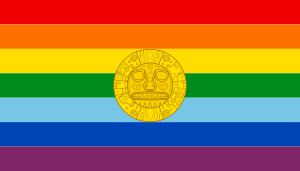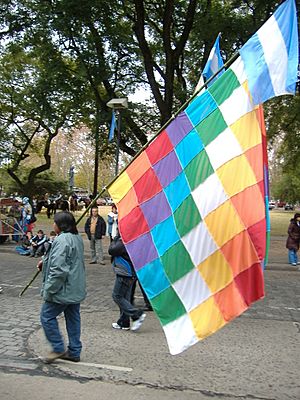Wiphala facts for kids
The Wiphala is a special square flag used by some native peoples in the Andes mountains. These groups live in areas that are now countries like Peru, Bolivia, Chile, Ecuador, Argentina, and Colombia.
The Wiphala has a pattern of 7 × 7 squares, making a total of 49 small squares. These squares are arranged in seven colors, placed diagonally. The color of the longest diagonal line (seven squares) shows which of the four main regions (called suyu) the flag represents:
- White for Qullasuyu
- Yellow for Kuntisuyu
- Red for Chinchaysuyu
- Green for Antisuyu
Since 2009, the southern Qullasuyu Wiphala has been one of the two official flags of Bolivia, alongside the red, yellow, and green flag.
Contents
History of the Wiphala Flag
Ancient Origins of the Wiphala
In modern times, the Wiphala is sometimes confused with a seven-striped rainbow flag. This rainbow flag is wrongly linked to the Inca Empire (also called Tawantinsuyu). Historians debate if the Inca Empire ever had a flag.
The oldest known example of a Wiphala-like design is on a bag for coca leaves. This bag comes from the Tiwanaku culture, which existed between 1580 BC and AD 1187. The bag is now in the Brooklyn Museum.
Another old Wiphala was found in the Tiwanaku region and is now in a museum in Sweden. Scientists used a C-14 test to find out it is from the 11th century.
Wiphala in Old Writings
Writers from the 16th and 17th centuries, called chroniclers, wrote about banners used by the Inca. These banners represented the Inca people, not the whole empire. Their designs came from symbols and murals used by Andean civilizations for thousands of years.
Francisco López de Jerez wrote in 1534 that Inca groups marched "with their flags and commanding captains."
Another chronicler, Bernabé Cobo, wrote in 1653 that the Inca royal banner was a small, square flag. It was made of cotton or wool and carried on a long pole. Each Inca ruler had their own symbols on their banner, but many used the rainbow.
In 1615, Guaman Poma's book El primer nueva corónica y buen gobierno showed many drawings of Inca flags.
Colors and Their Meaning
The seven colors of the Wiphala are like those of the rainbow. According to one interpretation, each color has a special meaning:
- Red: Represents the Earth and the Andean people.
- Orange: Stands for society and culture.
- Yellow: Means energy and strength.
- White: Symbolizes time and change.
- Green: Represents natural resources and wealth.
- Blue: Stands for the Cosmos (the universe).
- Violet: Means Andean government and self-determination.
Wiphala and Andean Social Movements

Social Movements in Ecuador
In Ecuador, the Wiphala is a symbol for Indigenous social movements. The main group is called CONAIE (Confederation of Indigenous Nationalities of Ecuador). This group has been important in big protests since the late 1990s. The CONAIE flag is a Wiphala with a mask from an ancient Ecuadorian people called La Tolita in the middle.
The Wiphala is often seen in marches by CONAIE. It is also used by their political group, the Movimiento de Unidad Plurinacional Pachakutik - Nuevo País. This group takes part in elections and has many members in the government. The word Pachakutik is from the Quechua language and means hope for a better future for Andean people.
The Bolivian Wiphala
The Aimara Wiphala is a square flag with 49 squares. The seven rainbow colors are placed in diagonal patterns. The exact colors and arrangement can change depending on the region or group it represents. This flag is very important in marches by Indigenous and farmer groups in Bolivia.
This "rainbow squares" flag is used as a general flag for Andean peoples in Bolivia. Recently, some groups from the Amazon region have also started using it when they form political alliances.
In 2009, Bolivian president Evo Morales made the Qullasuyu Wiphala an official dual flag of the nation. It is now flown on government buildings, like the Palacio Quemado, and even on the national airplane.
During a time of political changes in Bolivia in 2019, some police removed the Wiphala from uniforms, and some protesters burned it. This was later criticized by the acting president, Jeanine Áñez, who said it was wrong to destroy Indigenous heritage.
Confusion with the Flag of Cusco

The Wiphala is sometimes confused with the seven-striped rainbow flag of the Peruvian city of Cusco. This rainbow flag is often seen on government buildings in Cusco. It is sometimes shown as a symbol of the Inca Empire, but historians and the Peruvian government have said that the Inca Empire never had an official flag. While the Wiphala is mainly linked to the Aymara people, the Inca people were originally from the Quechua people.
Images for kids
See also
 In Spanish: Wiphala para niños
In Spanish: Wiphala para niños




